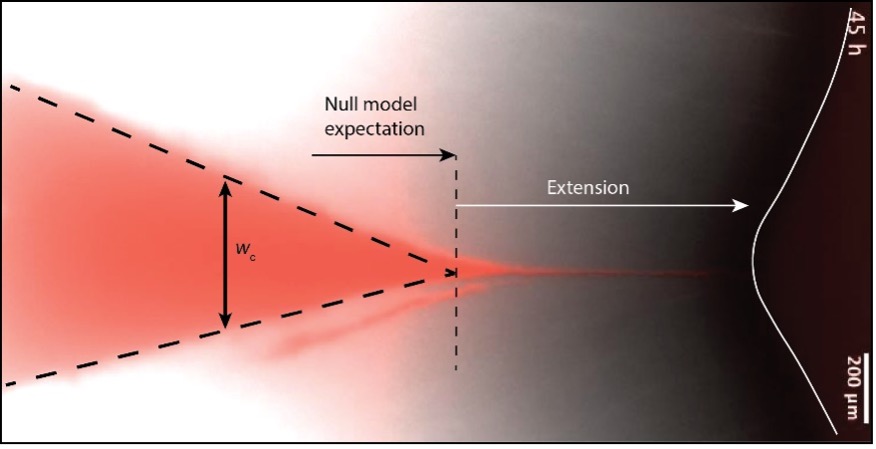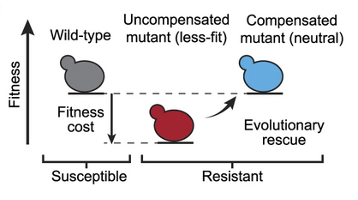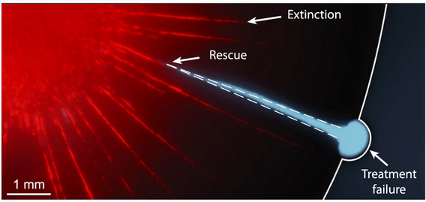Evolutionary rescue dynamics of resistant mutants
Behind the Paper
Evolutionary rescue of resistant mutants is governed by a balance between radial expansion and selection in compact populations
Serhii Aif, Nico Appold, Lucas Kampman, Oskar Hallatschek, Jona Kayser
Read the paperThe fitness cost of resistance has been one of the key assumptions in adaptive therapy. Its utilization aims to slow the development of resistance and increase the effectiveness of treatment. One common approach is to leverage the competition for space and nutrients between sensitive and resistant cells to maintain a tolerable tumor size and reduce the probability of progression. Understanding the cost of resistance and how space might change the dynamics of its evolution has implications on improving the effectiveness of treatment [1].

Recent studies have shown that the effective fitness difference felt by the slower-growing cells in mechanical competition assays is drastically decreased for the small clones in comparison to the non-mechanistic null model. Collective dynamics responsible for the width-dependent selection pressure are demonstrated to emerge inherently in microbial and bacterial evolution models as well as mechanistic tumor simulations [2, 3].
As many resistance mutations are associated with a fitness cost, they are subject to purifying selection and will eventually be outcompeted by non-resistant mutants. In principle, less-fit resistant clones can escape purifying selection via a subsequent compensatory mutation. However, the small size of de novo clones makes such a fitness valley crossing rare. In this paper [4], we investigate whether the probability of such an evolutionary rescue can be increased in dense populations by the aforementioned fitness screening as a result of collective cell dynamics.


We investigated this using a genetically tailored yeast-based model. Fluorescently labeled resistant and susceptible S. cerevisiae strains are subject to local competition in radially growing 2D colonies. Slower-growing red-fluorescent resistant cells can mutate stochastically to a fitness-compensated state at an externally controlled rate and simultaneously change their fluorescence to cyan via a recombinase-based “synthetic mutations” system. Introducing this fluorescence-augmented mutation system allows tracking the entire evolutionary dynamics of clones with high spatio-temporal resolution.
We find that the slower-growing resistant clone’s width at the propagating front rises initially with increasing radius but then saturates and remains constant at an equilibrium width. This stabilization is a result of the interplay between width-dependent natural selection and periphery inflation due to radial expansion. For a slower-growing clone, the two forces oppose each other with inflation increasing the clone size and purifying selection driving the mutant to extinction. Further investigation of this phenomenon with a mathematical range expansion model of a biased random walk shows that width-dependent selection is required for the stable equilibrium.

Evolutionary rescue probability is greatly increased in dense populations as a result of the aforementioned dynamics. Additionally, we demonstrate how width stabilization, together with compensatory mutations, influence overall clone survival and treatment failure probability. Comparing samples with high mutation rates to a control with negligibly rare mutations, we show that the effect of compensations is delayed significantly.
Finally, to expand the generality of our findings and their potential applicability to solid tumors, we conduct agent-based simulations of the growing tumors using PhysiCell [5]. This additionally demonstrates that the inflation-selection balance only requires a minimal set of ingredients inherent to many sufficiently dense populations exhibiting radial expansion, including solid tumors. Utilizing computational modelling, we investigate how timing of compensatory mutations impacts long-term treatment success. We hope that the strides taken towards understanding drug resistance evolution and connection to physics explored in this work have the potential to aid in designing better evolution-based therapies.
References
- Strobl, M. A., Gallaher, J., West, J., Robertson-Tessi, M., Maini, P. K., & Anderson, A. R. (2022). Spatial structure impacts adaptive therapy by shaping intra-tumoral competition. Communications medicine, 2(1), 1-18. doi: 10.1038/s43856-022-00110-x
- Kayser, J., Schreck, C.F., Gralka, M. et al. Collective motion conceals fitness differences in crowded cellular populations. Nat Ecol Evol 3, 125–134 (2019). doi: 10.1038/s41559-018-0734-9
- Giometto, A., Nelson, D. R., & Murray, A. W. (2018). Physical interactions reduce the power of natural selection in growing yeast colonies. Proceedings of the National Academy of Sciences, 115(45), 11448-11453. doi: 10.1073/pnas.1809587115
- Aif, S., Appold, N., Kampman, L., Hallatschek, O. & Kayser, J. (2022). Evolutionary Rescue of Resistant Mutants Is Governed by a Balance between Radial Expansion and Selection in Compact Populations. Nature Communications, 13(1), 7916. doi: 10.1038/s41467-022-35484-y
- Ghaffarizadeh, A., Heiland, R., Friedman, S. H., Mumenthaler, S. M., & Macklin, P. (2018). PhysiCell: an open source physics-based cell simulator for 3-D multicellular systems. PLoS computational biology, 14(2), e1005991. doi: 10.1371/journal.pcbi.1005991
© 2025 - The Mathematical Oncology Blog